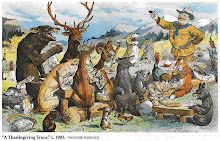Feds Ignore Mexican Wolf Science for 10 Years;
Endangered Animals Have Paid Steep Price for Mismanagement
SILVER CITY, N.M.— This week marks the 10-year anniversary of the release of the Paquet Report by a blue-ribbon panel of independent scientists who urged that management of endangered Mexican gray wolves be changed "immediately" to ensure urgently needed "dramatic improvement" in wolf survival and reproduction rates. Instead, for 10 years the U.S. Fish and Wildlife Service, which had convened the scientists (led by renowned wolf biologist Dr. Paul C. Paquet), has offered excuses as to why it has not yet made the requisite reforms. As a result, the report's warning that "the wolf population will fall short of predictions for upcoming years" has come to pass, putting the Mexican wolf at increasing risk of extinction due to genetic inbreeding caused by too few wolves that are too closely related to each other. "A decade has gone by with no action from the government," said Michael Robinson of the Center for Biological Diversity, which has long advocated for the wolves. "The result has been that the Mexican wolf population limps along every year and never grows to the point where its long-term viability can be ensured."
The 86-page Paquet Report — officially titled Mexican Wolf Recovery: Three-Year Program Review and Assessment — recommended that the Fish and Wildlife Service "Immediately modify the final [reintroduction] rule (Parsons 1998) and develop the authority to conduct initial releases into the Gila National Forest" in New Mexico. The area makes up three-quarters of the Blue Range Wolf Recovery Area but biologists can only release wolves there that have been previously captured from the wild after having been released into Arizona's smaller portion of the recovery area, or after having been born in the wild in Arizona or New Mexico. (Forty-seven of the 50 wolves that could be counted in the wild in January of this year were born in the wild; just three were born in captivity and released.)
The portion of the recovery area in Arizona, on the Apache National Forest, has limited room for additional releases because territorial wolf packs already occupy the best habitats; this year's half-million-acre Wallow fire has further limited possibilities for releases in Arizona. The provision in the 1998 reintroduction rule limiting initial releases to Arizona stems from the greater political clout that ranchers in New Mexico wielded at the time. No other endangered animal's management is limited by state lines.The Paquet Report also recommended: "Immediately modify the final rule to allow wolves that are not management problems to establish territories outside the Blue Range Wolf Recovery Area." This reform, also not yet implemented, would bring management to the same standards as that for other endangered wildlife, including wolves elsewhere that are not persecuted unless they are causing tangible problems. However, the Fish and Wildlife Service has bound itself to remove Mexican wolves that establish territories wholly outside the recovery area, even if the wolves are on national forests and are not preying on livestock.
"Wolves can't read maps drawn by politicians," said Robinson. "The Fish and Wildlife Service should change its rule to allow Mexican wolves to roam freely, just like other wildlife, and should give itself the authority to release wolves from captivity into New Mexico. Otherwise, in another 10 years we may not have any Mexican wolves in the wild."










No comments:
Post a Comment